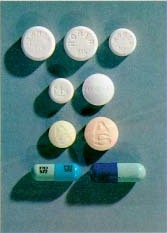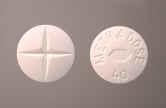|
Mandelin Reagent
The Mandelin reagent is used as a simple spot-test to presumptively identify alkaloids as well as other compounds. It is composed of a mixture of ammonium metavanadate and concentrated sulfuric acid. Its primary use is for the detection of ketamine and PMA Unlike the most common reagent test chemicals, it has a deep red colour that changes to yellow if there is no alkaloid, which occurs within about 48 hours of mixing. The United States Department of Justice method for producing the reagent is the addition of 100 mL of concentrated (95–98%) sulfuric acid to 0.5-1 g of Ammonium metavanadate. This reagent was invented by the German pharmacologist, Karl Friedrich Mandelin (1854–1906) at the University of Dorpat. See also *Drug checking *Dille–Koppanyi reagent *Folin's reagent *Froehde reagent *Liebermann reagent *Marquis reagent *Mecke reagent *Simon's reagent * Zwikker reagent The Zwikker reagent is used as a simple spot-test to presumptively identify barbiturates. It ... [...More Info...] [...Related Items...] OR: [Wikipedia] [Google] [Baidu] |
Alkaloids
Alkaloids are a class of basic, naturally occurring organic compounds that contain at least one nitrogen atom. This group also includes some related compounds with neutral and even weakly acidic properties. Some synthetic compounds of similar structure may also be termed alkaloids. In addition to carbon, hydrogen and nitrogen, alkaloids may also contain oxygen, sulfur and, more rarely, other elements such as chlorine, bromine, and phosphorus.Chemical Encyclopedia: alkaloids xumuk.ru Alkaloids are produced by a large variety of organisms including , , |
Dimethoxymethamphetamine
3,4-Dimethoxy-''N''-methylamphetamine (DMMA) is a psychoactive drug and research chemical of the phenethylamine and amphetamine chemical class Chemical classification systems attempt to classify elements or compounds according to certain chemical functional or structural properties. Whereas the structural properties are largely intrinsic, functional properties and the derived classificat ...es. It appears to act as a serotonin–norepinephrine–dopamine releasing agent (SNDRA), although it is significantly less potent than MDMA. References Serotonin-norepinephrine-dopamine releasing agents Methamphetamines {{psychoactive-stub ... [...More Info...] [...Related Items...] OR: [Wikipedia] [Google] [Baidu] |
Opium
Opium (or poppy tears, scientific name: ''Lachryma papaveris'') is dried latex obtained from the seed capsules of the opium poppy ''Papaver somniferum''. Approximately 12 percent of opium is made up of the analgesic alkaloid morphine, which is processed chemically to produce heroin and other synthetic opioids for medicinal use and for the illegal drug trade. The latex also contains the closely related opiates codeine and thebaine, and non-analgesic alkaloids such as papaverine and noscapine. The traditional, labor-intensive method of obtaining the latex is to scratch ("score") the immature seed pods (fruits) by hand; the latex leaks out and dries to a sticky yellowish residue that is later scraped off and dehydrated. The word '' meconium'' (derived from the Greek for "opium-like", but now used to refer to newborn stools) historically referred to related, weaker preparations made from other parts of the opium poppy or different species of poppies. The production methods have ... [...More Info...] [...Related Items...] OR: [Wikipedia] [Google] [Baidu] |
Morphine
Morphine is a strong opiate that is found naturally in opium, a dark brown resin in poppies (''Papaver somniferum''). It is mainly used as a analgesic, pain medication, and is also commonly used recreational drug, recreationally, or to make other illicit drug, illicit opioids. There are numerous methods used to administer morphine: oral; sublingual administration, sublingual; via inhalation; intramuscular, injection into a muscle; by Subcutaneous injection, injection under the skin; intravenously; Intrathecally, injection into the space around the spinal cord; transdermal; or via rectal administration, rectal suppository. It acts directly on the central nervous system (CNS) to induce analgesia and alter perception and emotional response to pain. Physical and psychological dependence and tolerance may develop with repeated administration. It can be taken for both acute pain and chronic pain and is frequently used for pain from myocardial infarction, kidney stones, and during Ch ... [...More Info...] [...Related Items...] OR: [Wikipedia] [Google] [Baidu] |
Methylphenidate
Methylphenidate, sold under the brand names Ritalin and Concerta among others, is the most widely prescribed central nervous system (CNS) stimulant medication used to treat attention deficit hyperactivity disorder (ADHD) and, to a lesser extent, narcolepsy. It is a primary medication for ADHD; it may be taken by mouth or applied to the skin, and different formulations have varying durations of effect, commonly ranging from 2–4 hours. Though there is little to no evidence, and in some cases contradictory evidence, to support its use as an athletic performance enhancer, cognitive enhancer, aphrodisiac or euphoriant, claims persist that it can be used for these purposes. Common adverse reactions of methylphenidate include: tachycardia, palpitations, headache, insomnia, anxiety, hyperhidrosis, weight loss, decreased appetite, dry mouth, nausea, and abdominal pain. Withdrawal symptoms may include: chills, depression, drowsiness, dysphoria, exhaustion, headaches, irritabili ... [...More Info...] [...Related Items...] OR: [Wikipedia] [Google] [Baidu] |
Methaqualone
Methaqualone is a hypnotic sedative. It was sold under the brand names Quaalude ( ) and Sopor among others, which contained 300 mg of methaqualone, and sold as a combination drug under the brand name Mandrax, which contained 250 mg methaqualone and 25 mg diphenhydramine within the same tablet, mostly in Europe. Commercial production of methaqualone was halted in the mid-1980s due to widespread abuse and addictiveness. It is a member of the quinazolinone class. The sedative–hypnotic activity of methaqualone was first noted in 1955. In 1962, methaqualone was patented in the United States by Wallace and Tiernan. Its use peaked in the early 1970s for the treatment of insomnia, and as a sedative and muscle relaxant. Methaqualone became increasingly popular as a recreational drug and club drug in the late 1960s and 1970s, known variously as "ludes" or "disco biscuits" due to its widespread use during the popularity of disco in the 1970s, or "sopers" (also "soaps") ... [...More Info...] [...Related Items...] OR: [Wikipedia] [Google] [Baidu] |
Methadone
Methadone, sold under the brand names Dolophine and Methadose among others, is a synthetic opioid agonist used for chronic pain and also for opioid dependence. It is used to treat chronic pain, and it is also used to treat addiction to heroin or other opioids. Prescribed for daily use, the medicine relieves cravings and removes withdrawal symptoms. Detoxification using methadone can be accomplished in less than a month, or it may be done gradually over as long as six months. While a single dose has a rapid effect, maximum effect can take up to five days of use. The pain-relieving effects last about six hours after a single dose. After long-term use, in people with normal liver function, effects last 8 to 36 hours. Methadone is usually taken by mouth and rarely by injection into a muscle or vein. Side effects are similar to those of other opioids. These frequently include dizziness, sleepiness, vomiting, and sweating. Serious risks include opioid abuse and respiratory depre ... [...More Info...] [...Related Items...] OR: [Wikipedia] [Google] [Baidu] |
Mescaline
Mescaline or mescalin (3,4,5-trimethoxyphenethylamine) is a naturally occurring psychedelic protoalkaloid of the substituted phenethylamine class, known for its hallucinogenic effects comparable to those of LSD and psilocybin. Biological sources It occurs naturally in several species of cacti. It is also found in small amounts in certain members of the bean family, Fabaceae, including ''Acacia berlandieri''. However those claims concerning ''Acacia'' species have been challenged and have been unsupported in any additional analysis. History and use Peyote has been used for at least 5,700 years by Indigenous peoples of the Americas in Mexico. Europeans noted use of peyote in Native American religious ceremonies upon early contact, notably by the Huichols in Mexico. Other mescaline-containing cacti such as the San Pedro have a long history of use in South America, from Peru to Ecuador. While religious and ceremonial peyote use was widespread in the Aztec empire and northern M ... [...More Info...] [...Related Items...] OR: [Wikipedia] [Google] [Baidu] |
MDMA
3,4-Methylenedioxymethamphetamine (MDMA), commonly seen in Tablet (pharmacy), tablet form (ecstasy) and crystal form (molly or mandy), is a potent empathogen–entactogen with stimulant properties primarily used for Recreational drug use, recreational purposes. The desired effects include altered Sense, sensations, increased energy, empathy, and pleasure. When taken by mouth, effects begin in 30 to 45 minutes and last 3 to 6 hours. MDMA was first developed in 1912 by Merck Group, Merck. It was used to enhance psychotherapy beginning in the 1970s and became popular as a street drug in the 1980s. MDMA is commonly associated with dance party, dance parties, raves, and electronic dance music. It may be Cutting agent, mixed with other substances such as ephedrine, amphetamine, and methamphetamine. In 2016, about 21 million people between the ages of 15 and 64 used ecstasy (0.3% of the world population). This was broadly similar to the percentage of people who use cocaine ... [...More Info...] [...Related Items...] OR: [Wikipedia] [Google] [Baidu] |
3,4-Methylenedioxyamphetamine
3,4-Methylenedioxyamphetamine (also known as MDA and sass) is an empathogen-entactogen, psychostimulant, and psychedelic drug of the amphetamine family that is encountered mainly as a recreational drug. In terms of pharmacology, MDA acts most importantly as a serotonin–norepinephrine–dopamine releasing agent (SNDRA). In most countries, the drug is a controlled substance and its possession and sale are illegal. MDA is rarely sought after as a recreational drug compared to other drugs in the amphetamine family; however, it remains an important and widely used drug due to it being a primary metabolite, the product of hepatic N-dealkylation, of MDMA (ecstasy). In addition, it is common to find MDA as an adulterant of illicitly produced MDMA. Uses Medical MDA currently has no accepted medical use. Recreational MDA is bought, sold, and used as a recreational 'love drug', due to its enhancement of mood and empathy. A recreational dose of MDA is sometimes cited as being b ... [...More Info...] [...Related Items...] OR: [Wikipedia] [Google] [Baidu] |
Mace (spray)
Mace is the brand name of an early type of aerosol self-defense spray invented by Alan Lee Litman in the 1960s. The first commercial product of its type, Litman's design packaged phenacyl chloride (CN) tear gas dissolved in hydrocarbon solvents into a small aerosol spray can, usable in many environments and strong enough to act as a deterrent and incapacitant when sprayed in the face. A generic trademark, its popularity led to the name "mace" being commonly used for other defense sprays regardless of their composition, and for the term "maced" to be used to reference being pepper sprayed. It is unrelated to the spice mace. History The original formulation consisted of 1% chloroacetophenone (CN) in a solvent of 2-butanol, propylene glycol, cyclohexene, and dipropylene glycol methyl ether. Chemical Mace was originally developed in the 1960s by Allan Lee Litman and his wife, Doris Litman, after one of Doris's female colleagues was robbed in Pittsburgh. In 1987, Chemical Mace was ... [...More Info...] [...Related Items...] OR: [Wikipedia] [Google] [Baidu] |
Ketamine
Ketamine is a dissociative anesthetic used medically for induction and maintenance of anesthesia. It is also used as a recreational drug. It is one of the safest anesthetics, as, in contrast with opiates, ether, and propofol, it suppresses neither respiration nor heart rate. Ketamine is also simple to administer and highly tolerable compared to drugs with similar effects which are flammable, irritating, or even explosive. Ketamine is a novel compound, derived from PCP, created in pursuit of a safer anesthetic with similar characteristics. Ketamine is also used for acute pain management. At anesthetic doses, ketamine induces a state of "dissociative anesthesia", a trance-like state providing pain relief, sedation, and amnesia. The distinguishing features of ketamine anesthesia are preserved breathing and airway reflexes, stimulated heart function with increased blood pressure, and moderate bronchodilation. At lower, sub-anesthetic doses, ketamine is a promising agent for pain ... [...More Info...] [...Related Items...] OR: [Wikipedia] [Google] [Baidu] |





